












Last Gasps
Paranormal



The South’s science-based team!
Our trained investigators are here to believe you. Most importantly, we are here to solve the problem...no matter what it takes. Our services are always FREE.

© 2023 Last Gasps paranormal. Links | Terms and Conditions






Spirit Trap
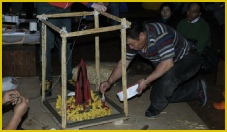


Eastern Demons


Disclaimer: This work has been completed as an educational tool for students of history, religious and paranormal studies. The author wishes to discourage any use of this work in conjunction with paranormal field investigations of demons.
Presented by Kyle T. Cobb, Jr. to the audience of Dragon-Con 2013
Nos tibi credere.
A Literary History
Introduction
"Long lips reaching out from where one hundred males gather send envious talk (mi-kha) like an arrow; where one hundred females gather, it is like spun wool... where one hundred demonesses gather, it flows like water... In Tibet the dharma is dying out, like beings who are near death. Oceans are drying up, the Life Tree is falling. The big lips of the nine mi-kha brothers are coming...”
These words are taken from the Tibetan exorcism ritual. It expresses the belief that the world is moving from an age of prosperity into one of decline. The entropic decline is being led by the 9 demonic Gong-po brothers that can take many forms like the mi-kha, or lords of envious talk.
For someone here in the United States, names, pictures and stories of demons from places like India or Tibet may seem strange and exotic. Yet at the very core, there are a striking number of similarities to those found in the West.
Let us roll back time for a moment and look briefly at the current scientific Mythology on the history of man:
Homo sapiens evolved 200,000 years ago in central Africa.
Humans began speaking around 100,000 years ago
The earliest known writing so far discovered is from a Harappan settlement in Pakistan and dates to 4,100 BC
The earliest decipherable surviving writing system was developed around 3,600 BC(5,000 years ago) in Mesopotamia as a system of symbols to represent numbers
This is not to say that there was not symbolic representations prior to this point.
Before the Mesopotamian era, there is only art. Several prominent examples are:
the face in stone in Angouleme, France that was created 27,000 years ago
the cave paintings in Malaga, Spain created 43,500 years ago
While the symbols give us an impression, they do not tell a story. And more importantly, they give only interpretive information. Even if these dates are off by thousands of years, the point remains the same, we as humans only have record of a tiny fraction of our interactions with the universe around us.
So for better or worse... our history... Our stories are mostly lost
Yet from our earliest stories, there have been tales of spirits... of Gods... and of demons. Before there was Christianity... Before there was Buddhism... There was a world with tribal gods and demons that were tangible representatives of the forces of nature. In this world, demons were just as real and just a fearsome as the yearly outbreaks of influenza. While the names of these creatures varied from village to village and through languages groups, most shared similar origins and characteristics. For tens of thousands of years this was the case around the world.
Suddenly 2500 years ago everything changed with a young Macedonia warrior king called Alexander. As the armies of Alexander swept through the Middle East not only did they bring the Greek culture, they brought with them Greek religious philosophy. This conquest and cultural exchange laid the ground work for the eventual spread of Christian religious ideas throughout the West. So for the Europeans, the old tribal gods and demons were suppressed and merged with the more philosophical and less physical Christian religion. Yet to the east of Alexander's conquest, the "global" spiritual religion would take a different form. In India, Tibet, to some extent Japan and Indonesia, Buddhism would provide the spiritual template that would become the predominant religion. As Buddhism spread, like Christianity it was forced to merge with the many tribal religions that were already in place. Unlike Christianity's spread, the passive tenants of Buddhism tended to embrace alternative religions rather than violently suppress them. So while in the western world, demons have been made to represent the most evil aspects of the universe. They are feared, talked about in whispers and when necessary asked to leave. In Asia, demons are treated as either a part of nature to be embraced or when the demons are evil, they are destroyed. If we travel even further to the east, beyond the early reach of Christianity and Buddhism, it is even possible to see Demons and religions in place with only a 500 year influence of the two early global religions.
In starting to explore the world of Demonology, we need a firm definition of "what is a demon".
Definition of a demon
In the Western world, we tend to define demons based on the outward symptoms of a possession. There are 5 generally accepted characteristics that must be met for a demonic possession:
Will
o The demon must express a distinct will outside of its host and exercise that will.
o Promise of a demon to return to harm the host.
Emotion
o A demon will react to emotional stimuli or threats to itself that would not ordinarily harm the host. For example reaction to the threat of exorcism or banishment
Intellect
o Display of knowledge beyond a natural source of the host
Self-Awareness
o The claim that the personality is unique and distinct from the host's personality
Speech
Literature is filled with cases of the supposed demon speaking through its host and having a distinctly different personality or vocal pattern. This includes speaking languages unknown to the host.
In studying Eastern demons, possession is only one possibility.
As we will discuss, Eastern demons are often given more physical characteristics based of the residual influence of the tribal cultures before the arrival of Buddhism. For example:
Most non-western demons are cannibals. Many are outcast.
Tibetan demons are mostly invisible, extra-planar beings.
Hindu demons are often described as physical monsters, illnesses or possessing spirits.
Japanese demons are traditionally fearsome Ogres but can also illness or nature spirits.
Mesoamerican demons are the forces of nature given physical form.
So for our purposes today, we are going to stick to the rather vague assertions that:
A demon has not previously been a human.
A subject under demonic influence is not exhibiting normal symptoms of a scientifically definable physical or mental disease.
Demonic influence must have outward manifestations beyond the explainable abilities of an associated host.
A demon is assumed to be of limited power and therefore at a lower level than a primary deity.
Now that we have a definition, we may begin.
Gilgamesh
Let us start our worldwide journey with the beginning of recorded history and one of the most complete of the early stories, the epic of Gilgamesh. Luckily for us, not only has this story been preserved but it also contains the first concrete references to demons.
In the ancient Sumerian texts, there are three basic classes of supernatural:
Disembodied human spirits
Half-monster, half-human entities
Non-human forces
Utukku
The most prevalent in the Gilgamesh saga is the Utukku which is initially the spirit ghost of Gilgamesh's companion Eabani. Gilgamesh asks the god Nergal to return Eabani to him and the god complies. The term Utukku eventual changes in Sumerian and Babylonian text to be a kind of demon that haunts barren places and harms man.
Often associated with the breaking of a taboo, the Utukku is described as prowling like a dog and faster than a falling star. The female, called a Lamashtu, has a hairy body, a lion's head, donkey teeth and donkey ears. She also has long fingernails and the feet of a bird. One reference in a spell describes the creatures:
"A door cannot exclude them ,A bolt cannot turn them back; They slither through the door like a snake, They blow in by the hinge like the wind, They bear off the wife from a man's embrace; They snatch the son from a man's knee."
-Extract from a Mesopotamian
Alu (Gallu)
The second demon from Gilgamesh is Alu. When Anu wants to avenge his daughter lshtar on Gilgamesh and Eabani, he creates a celestial bull named Alu to attack them. Like the Utukku, this term evolved. Alu seems to be derived from the Sumerian term Gallu which means "tempest." Ironically as these terms blend Gallu also refers to a bull spirit that hunts at night.
Lilu
The lilu are the Babylonian prototypes for the incubus/succubus legends. The Lilu, like their modern counter parts, are represented as having sex with humans to steal life-force or to become impregnated. Like the alien abduction phenomena, the real origin of these demons may be related to sleep paralysis rather than supernatural.
Thanks to bad translations and bad history, the Lilu have been retroactively branded as the origin of the Jewish Lilith mythology. Contemporary translations firmly assert that that the Lilith linkage is incorrect.
Shedim
With the name derived from the Babylonian name meaning "to be violent", the Shedim are the winged bulls used to guard temples in Babylon and Assyria. They are referenced to in both curses as well as spells of protection.
If in a broad sense the religion of a Gilgamesh could be assumed as typical in the pre-universal religion period, then it is easier to see how the spread of religions has resulting in the merging and transfer of ideas.


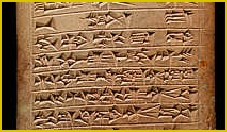
A sample of Mesopotamian cuneiform

An image of Gilgamesh slaying the Gallu
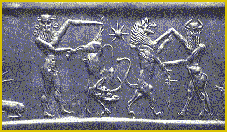

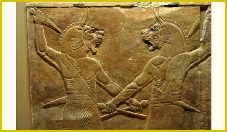
Utukku

A Lilu
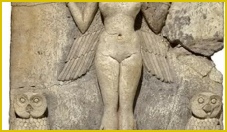

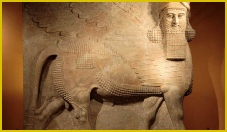
Shedim

The world of Alexander the Great.
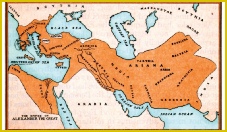
| Paranormal Books |
| Apparitions |
| Cryptids |
| Demons |
| Orbs |
| Poltergiest |
| Residual Hauntings |
| Shadow People |
| West Demons |
| Ouija and Zozo |
| Exorcisms |
| Anneliese Michel |
| Ronald Hunkeler |
| Anna Ecklund |
| LaToya Ammons |
| George Lukins |
| Christian Demon texts |
| Roman Rite 1614 |
| Roman Rite 1998 |
| Eastern Demons |
| FAQ |